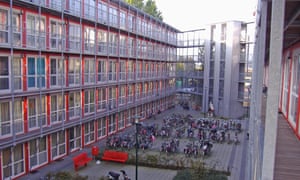What a fabulous way to warehouse socialists."
Living in a steel box: are shipping containers really the future of housing?
From London to Amsterdam to Mumbai, shipping containers have been celebrated as a cheap and easy way to provide pre-fab housing. But what is it like to live in one – and can they transcend pop-up status to be a permanent solution?
It takes time to adjust to living inside a steel box. Timothy Ader did not, initially, like the idea of staying at Wenckehof, a student village in Amsterdam made up of 1,000 recycled shipping containers. But three years after moving in, he has no regrets.
“My first impression of the containers was, ‘It’s ghetto stuff – I’m not living there,’” recalls the 24-year-old. “But I started visiting a friend of mine living here and started to like the place. Then I moved in and I realised how good it was. I’m really comfortable in my container and I have a lot of space of my own. I wouldn’t want to live anywhere else in the world right now.”
The Wenckehof, completed back in 2006 and formerly known as Keetwonen, remains the largest development of its kind anywhere in the world. Although it was built as a temporary housing experiment, it proved so popular with students it was given permanent status by the Amsterdam authorities in 2011. And its success has intrigued architects and housing organisations looking for low-cost solutions to housing shortages in cities around the world.
In Berlin, repurposed shipping containers have been used for student accommodation, and, more recently, to house asylum seekers. In London, Forest YMCA have begun moving young working adults struggling to pay high rents and at risk of becoming homeless into 20 “mYPad” containers in Walthamstow– though occupants can only stay for a maximum of one year.


No comments:
Post a Comment